Eigenbrot's Beer (1935)
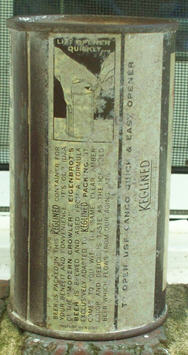 |
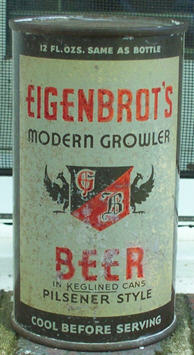 |
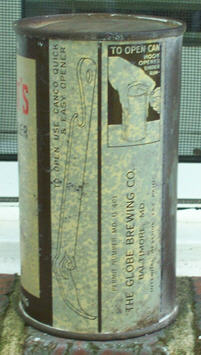 |
This month's can is an Eigenbrot's Beer OI from Baltimore. The red was touched up with a marker (ugh) which I hope to safely remove someday.
Eigenbrot's
Eigenbrot's was brewed by Baltimore's Globe Brewing. I discussed Globe's history under their main brand, Arrow Beer (my December 2004 COM). According to Who's Who in Brew, Globe only produced Eigenbrot's from 1935-1936. It came as both a beer and an ale, and both cans are hard to find, and the ale is the rarer of the two.
The name was chosen as a reference to another local pre-prohibition brewery.
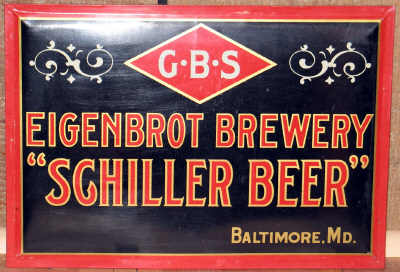 |
An early 20th century Eigenbrot's sign.
Here, FYI, is what they look like in indoor condition! And what my original Eigenbrot looked like before I upgraded! (thanks Steve!)
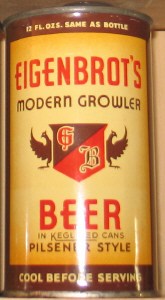 |
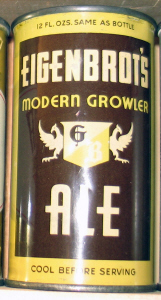 |
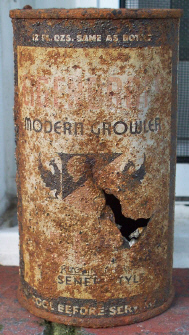 |
The "Growler"
Note that both cans have the phrase "Modern Growler" on them. "What", you may ask, "is a growler?" Originally it was a pitcher or pail that was used to carry beer. Before Prohibition most beer was sold "on draft." It was common for families to send someone, often a child, to a local saloon with a pitcher or pail to go get beer to go with the family's dinner. Boys in urban areas could make a little extra money by waiting outside factory gates at lunch time. They would take the small buckets from the men on their lunch break, run to the saloon to have them filled, then run them back to the men to have to drink at lunch or at work. This was called "rushing the growler."
This was a popular practice. In 1894, The Nebraska State Journal reported that "rushing the growler" was a "national habit." The Journal reported that a "growler" meant 10 cents worth of beer (approximately $2.44 in 2009 dollars). This was "twice as much beer for ten cents ... as you can get for the same money standing in front of a bar." The Journal noted that it was common for children or women to "rush the growler" for their families. Women could use the "family entrance" which was at the side of many pre-Prohibition saloons. "Once inside the booth [at the family entrance]" the woman "lays her bucket and ten cents on the window ledge and gets her beer." As for children, "it is against the law to sell liquor to them, but the bartender knows it is for home use, and knows the children to whom he sells, hence is is seldom detected." Children knew they had an opportunity to sample the beer themselves on the way home as well. Finally, the reporter writes, "On the east side [of New York] and the far west side*, and in all the tenement and small flat districts, the 'growler' is rushed all night long, or until the saloon closes." "Growler season," he continued, "decreases more than two-thirds during the winter months, when the saloons are compelled to manufacture hot drinks to offset the loss of the 'growler money.'" (*the lower East Side and the far West Side of Manhattan were working class and lower class districts with heavy immigrant populations.)
|
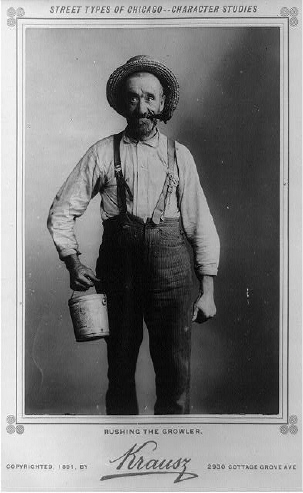 |
| (below) Hines, Lewis W. "Making willow plumes under unsanitary conditions." December 1911. LC-DIG-nclc-04106. Library of Congress Prints and Photographs Division, Washington, DC 20540 USA | (above) LC-USZ62-5423, Library of Congress Prints and Photographs Division, Washington, DC 20540 USA |
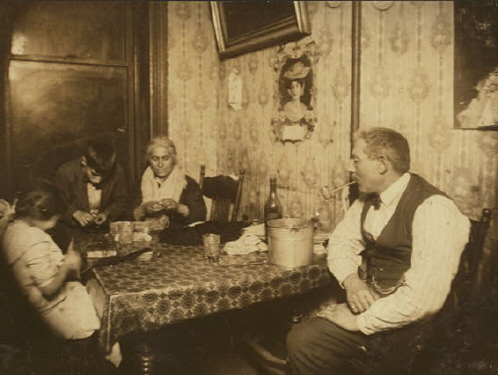 |
"A dirty home, the father and several friends had been rushing the growler and booze was literally flowing around over table and floor. The father is a truck-driver out of work. The mother, Freddie (11yrs. old) and Antoinette (8 yrs. old) all work $1.50 to $2.00 a week now, "but we make $3.00 a week in summer when we can work all day and not go to school." Vincent Tranutolo, 309 E. 110th St., ground floor. Location: New York, New York (State)" Lewis Hines was a a skilled photographer. Taking advantage of the new flash technology which allowed photographs to be taken in dark areas, he took thousands of photographs of the immigrants and their tenements in New York. This photo was one of the many he took to show how families lived and worked in New York in the early 20th century. |
Several breweries advertised their cans as a modern variation on this theme, a small metal bucket designed to carry beer.
 |
|
Detail from the Eigenbrot's Beer. |
Growlers, Noggins and Bumpers
Other breweries used other terms describing their cans that harkened to pre-prohibition days, such as "noggin" (a small mug or cup) or "bumper" (a glass or tankard filled to the brim for a toast.) as well as "growler." Here are some of the cans that used these alternative terms. (Thanks to Steve G. and Jeff D. for the photos of the Fehr's and the indoor Eigenbrot's.).
Brewery |
Term |
Photo |
| Fehr's (Louisville) | "silver bumper" | 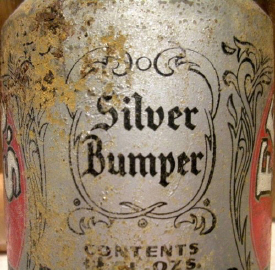 |
| Schmidt's (Philadelphia) | ||
Manhattan (Chicago, used on Manhattan Beer quarts) (see below) |
"growler" | 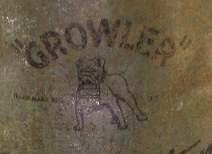 |
| Old Milwaukee (Schlitz) used on a 24 oz can) | "growler" | |
| Glueks (crowntainers) | "silver growler" |
The Manhattan quart deserves some more pics as they went all out on the "growler" theme, even adding "handles" on their quart label.
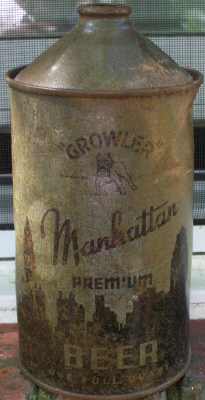 |
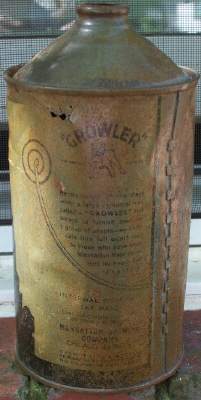 |
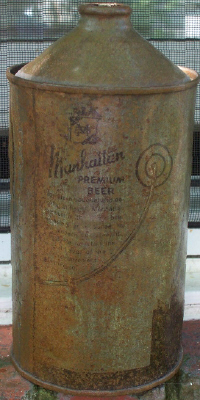 |
The side panel (above) reads... "Reminiscent of the days when a large container was called a "GROWLER" and served to furnish beer for a group of people--we dedicate this full quart size to those who have been Manhattan Beer devotees for nearly a century." The side panel to the right just tells you what great beer Manhattan is (was).
The logo (see above) has a bull dog carrying a growler bucket in his teeth. |
Sources Used
Hastings, Cecil. "Rushing the Growler" Nebraska State Journal. September 30, 1894.
Library of Congress Prints and Photographs Division
Newspaper Archive (link opens new window)
www.therustybunch.com (discussion board)
Who's Who in Brew
